Home is where the habitat is
A Charles Darwin University workshop will raise awareness about creating habitat holes for wildlife out of cut-down trees and stumps.
The free workshop at Palmerston campus will show participants how discarded wood could be cut safely by a chainsaw to create hollows, roosts and holes.
Arboriculture lecturer and organiser Philip Kenyon said the workshop would encourage participants to think twice before cutting down entire trees in their backyards.
“By turning the trunk into habitat instead of removing it, you could see microbats, frilled neck lizards, possums, parrots, and even kingfishers living there,” he said.
Mr Kenyon said residents could save money by removing hazardous limbs from a tree in their backyards, rather than uprooting an entire tree, if it were safe to do so.
He said the special chainsaw cutting technique could be administered by skilled operators only, for safety reasons. But Mr Kenyon also encouraged people who had an interest in wildlife or tree management to attend the workshop to understand the process and importance of habitat creation.
“We want the managers to see what can be done and to see it’s not that hard to create habitat to improve the environment,” he said.
Demonstrations about how to create habitat for water-dwelling animals by submerging logs and snags into water will also be shown at the workshop.
“There are very few hollows around Darwin,” Mr Kenyon said. “This is an area we could immensely improve by raising awareness about habitat creation.”
The Workshop in Arboreal Wildlife Habitat Creation will run at CDU’s Palmerston campus on Friday, July 18 from 9am until 4pm. For more information, contact Philip Kenyon: 040 940 2959.
